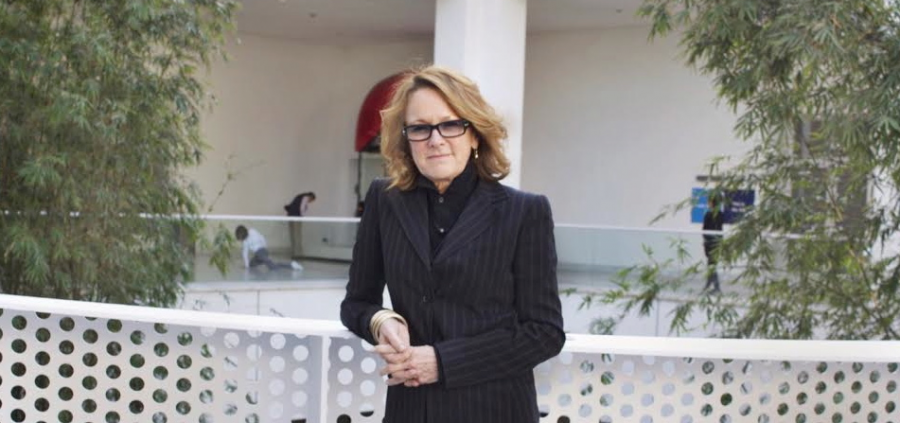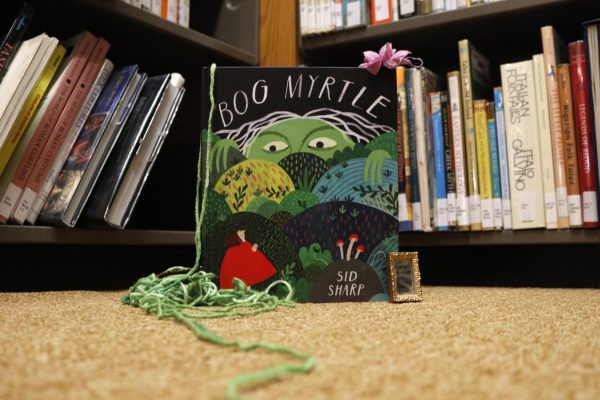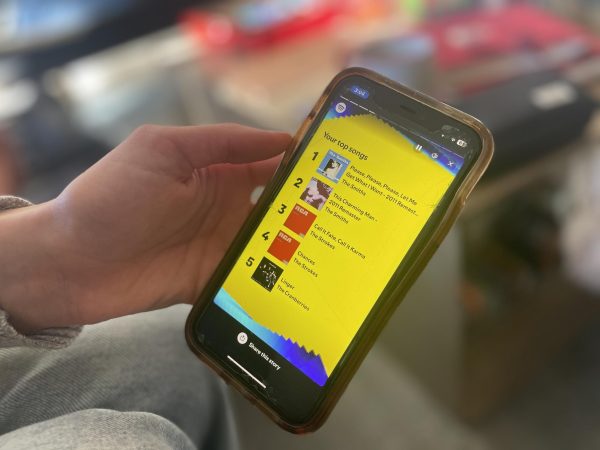Philbin Lays Down the Hammer
Photo credit: Siena Deck
Ann Philbin standing outside the Hammer Museum. Philbin is the first female director of the museum and has been in the position since 1999.
In an interview with Hammer Museum director, Ann Philbin, the Oracle got a closer look at what it’s like to be a woman in the art world. Philbin is the first woman director of the Hammer and the second director since its founding.
According to an SMU report by the Association of Art Museum Directors, women hold fewer than 50 percent of Association of Art Museum Directors (AAMD) member museum directorships and “the average female director’s salary lags behind that of the average male director.”
In fact, the report states that female art directors of museums with operating budgets exceeding $15 million earn only 71 cents for every dollar earned by a male director. (Interestingly, however, at lower-budget museums, with operating budgets of less than $15 million, female directors earn $1.02 for every dollar a man earns.)
The report also concludes that those who attain their directorship by starting as an intern and getting promoted will have a salary disadvantage regardless of gender. But if those people already held a director position, they gain a salary advantage. Many more women directors have attained their high positions via internal promotion, which factors into why the pay gap is so large, according to the study.
An article published by Artnet entitled “25 Women Curators on the Rise” describes the road these women took to acquire the jobs they have now. Female directors who started off in assistant-level positions include Katherine Brinson, who currently works at the Guggenheim in New York, Rachel Cook, currently the curator at Diverse Works, and Mika Yoshitake, an assistant curator at the Hirshhorn Museum.
According to its website, the Hammer Museum is “one of three public arts units of the School of Arts and Architecture at UCLA.”
The museum was opened in November of 1990 by Dr. Armand Hammer, the former chairman of Occidental Petroleum. Just three weeks after opening the museum, Dr. Armand Hammer passed away at the age of 92, from bone marrow cancer. At this juncture, UCLA assumed management responsibility of the museum. Then in 1999, Ann Philbin became the director of the museum.
A 2009 LA Times feature by Suzanne Muchnic explains how Philbin got to the Hammer: “Ann Philbin received a couple of letters from UCLA inviting her to apply for the top position at a fledgling museum near the university’s campus [The Hammer].”
In the piece, Philbin is quoted as saying, “I threw the letters in the garbage. I had never heard of UCLA at the Armand Hammer Museum of Art and Cultural Center.” But, still, she agreed to fly out and check it out.
“When I walked in,” Philbin said, “I had one of those eureka moments where I thought, ‘Uh-oh, I know exactly what this should be.’ So I agreed to go to an interview. I was offered the job and, much to my surprise, I took it. I thought I would stay for five or six years. Ten years later, I never think about going back to New York.”
The museum’s website states that it “champions the art and artists who challenge us to see the world in a new light, to experience the unexpected, to ignite our imaginations, and inspire change.”
“The Hammer understands that art not only has the power to transport us through aesthetic experience but can also provide significant insight into some of the most pressing cultural, political, and social questions of our time,” according to the site.
Under Philbin’s direction, the once “sleepy Hammer” has awoken to become a “hot spot for contemporary art and ideas and a venue for serious exploration of overlooked historical subjects,” according to the LA Times feature.
Lisa Phillips, director of the Museum of Contemporary Art in New York, explains how Philbin transformed the Hammer in the article: “Annie has effected a major transformation of the institution,” said Phillips. Phillips cites “very distinguished programming, the events that are staged there and the team [Philbin] has assembled” as the reasons for the positive change.
According to the museum’s website, Philbin “has formed a Hammer Contemporary Collection which now holds over 2,000 artworks. In addition, Philbin has overseen substantial renovations to the museum’s building, including the completion of the 300-seat Billy Wilder Theater and museum café.
Under Philbin’s direction, the museum instituted the internationally acclaimed Hammer Projects, a series of more than one hundred contemporary exhibitions and installations featuring local, national and international emerging artists. Philbin also created a series of dynamic public programs which are core to the Hammer’s identity and regularly feature many of the most influential authors, artists and creative thinkers of our time.”
With this in mind, the Oracle recently sat down with Philbin in her office at the Hammer. Her office was brightly lit with art on the walls, just as one would expect. The Oracle asked Philbin how she felt as a woman in her high-power position and if she faced any kinds of prejudice as a result of her gender.
DID YOU EVER FEEL PREJUDICE FOR BEING A WOMAN WHEN YOU WERE GROWING UP?
I was always aware that life was unbalanced and unfair to women. Both my parents worked, but the childcare and home duties all still fell to my mom. She had six kids and no help! Also, when I was growing up, every single TV show presented women as just housewives—I knew there was something wrong with that picture. It wasn’t until college that I began to understand the depth of inequality that existed between the sexes and how much suffering that caused in the world. It was a time of many battles, though—for civil rights, women’s rights, and also the protests against the Vietnam War. Boy, I sound old!
HOW DID THIS EXPERIENCE SHAPE YOU?
I knew that I would never allow my gender to be the reason that I was denied something. I hate injustice of any kind. I would say I was a feminist from my teens, although I had never heard that word. I’m so glad young women—and men—are embracing that word again. I became active in my politics in undergraduate school and was one of the founders of the Women’s Center at my university.
WHAT WAS YOUR EXPERIENCE LIKE AS A WOMAN STUDYING AT NYU?
Fantastic. It was a very exciting time for the contemporary art world and I was studying art and museum studies. My greatest experiences were my internships at small non-profit art spaces like Artists Space and the New Museum. Being out in the world and working around artists and curators was exhilarating. I was just doing helpful administrative duties at that time, but I was around the most interesting people, learning by osmosis.
HOW DID YOU GO FROM NYU TO WORKING FOR THE DRAWING CENTER?
I started by curating shows on my own in little hole-in-the-wall galleries in the East Village, I worked in a couple of galleries, and I also worked for an old master drawings collector, so I learned about the historical stuff, too. The truth is, I was not really prepared for the job at the Drawing Center as I had never worked in an institution, but I had a vision of what the place could be, and I had confidence and learned on the job. I also had a very supportive Board Chairman, and he mentored me and helped pave the way for me.
WHAT WOMEN DO YOU ADMIRE?
I admire girls and women all over the world who struggle against great adversity to educate themselves, push against boundaries and break barriers, manage to raise their children AND become artists, scientists, politicians, leaders. I particularly admire social activists who do not accept the status quo and constantly fight to make the world a better place. If you had told me 40 years ago that women would still be arguing for equal pay and the right to determine what we do with our bodies, I would not have believed you—so it’s a long path, and we have to stay vigilant and determined.
WHAT WOMEN ARTISTS DO YOU ADMIRE?
Cindy Sherman, Barbara Kruger, Cathy Opie, Patti Smith, Bjork, the list goes on and on.
WHEN WAS THE LAST TIME YOU FELT PROUD TO BE A WOMAN?
Pretty much all the time.
HAVE YOU EVER FELT LIKE YOUR IDEAS WERE SHOT DOWN DUE TO THE FACT THAT YOU’RE A WOMAN?
Sure, and I’m certain it has happened many times when I am not aware that it is happening. But it’s best to remember that that kind of behavior comes from a place of ignorance so, if possible, it’s best to just keep moving forward and ignoring it. Sometimes anger is helpful and sometimes it’s not.
WHAT’S IT LIKE TO BE A WOMAN IN SUCH A HIGH-POWER POSITION?
Well, I guess I don’t really think of it that way, but I feel proud of my accomplishments for sure. I’m especially proud to have built an incredibly talented, imaginative, and dedicated team of people that are devoted to the Hammer Museum. We all feel lucky to be working there.
HOW HAS THE HAMMER HELPED GIVE YOUR CONFIDENCE AS A WOMAN, OR DIMINISHED ANY CONFIDENCE AS A WOMAN?
What we have achieved at the Hammer—turning a moribund institution into a really exciting hub of art and ideas—has given me confidence that I am on the right track. It feels amazing to know that your work is bringing something good and valuable into the world. Culture is profoundly important to making a better world.
WHAT IS YOUR ADVICE FOR A TEENAGE GIRL ASPIRING TO SOMEDAY WORK IN A SIMILAR POSITION?
Be bold, be brave, be kind, question authority, and trust yourself.










